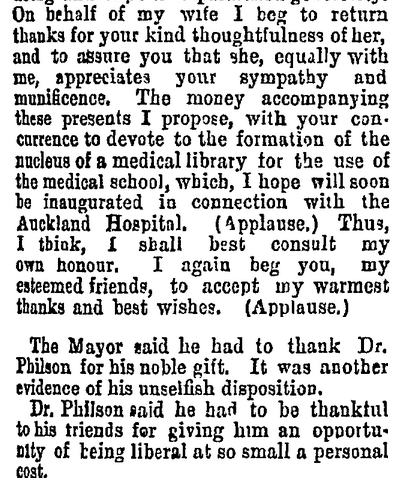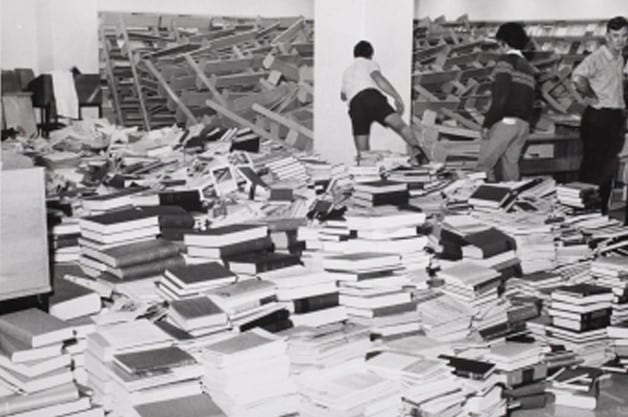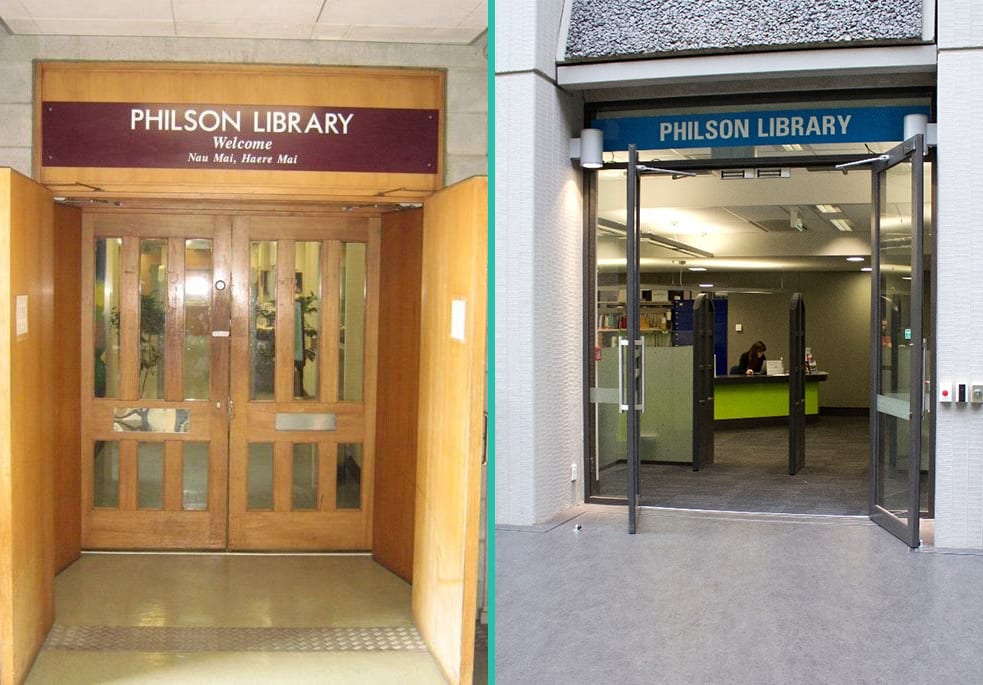TEACHING
Thomas Moore Philson (1817-99)
Thomas Moore Philson, son of a Londonderry schoolmaster, was one of four siblings who gained professional distinction. Two of his brothers became ministers of religion in America, where they were joined by another brother, William, an Edinburgh medical graduate. Thomas entered the British Army as an assistant surgeon in 1843, four years after graduating in medicine from the University of Edinburgh as the prize winner in military surgeon. Two years later he was posted to New Zealand, resigning his post in May 1851 for private practice in Auckland, where he remained until his death in 1899.
Philson was medical superintendent of Auckland Hospital 1859-83 and on his retirement was presented with a handsome gold chronometer and chain, a purse of sovereigns, and a silver card-case for Mrs Philson. He immediately donated the money towards the formation of a medical library for the medical school which he wished to see established in the very near future. His dream was not to be realised for another 85 years.
The Philson Library
From the 1920s Auckland University College acted as custodian to three distinct groupings of medical books – the Philson Collection, the Cathedral Collection (handed over by the Anglican Diocese), and the holdings of the Auckland Division of the British Medical Association (now the New Zealand Medical Association). In 1949, with no immediate prospect of an Auckland Medical School becoming reality, all of these were deposited on long-term loan with the Auckland Hospital Board. Twelve years later Sir Ernest Davis a wealthy Auckland brewer, endowed the Ernest and Marion Davis Library at the hospital, in memory of his wife who had died in 1955; the new library incorporated the Philson Collection.
The establishment of the Auckland Medical School in 1965 was followed by the appointment of the first librarian, Harry Erlam, in 1967. Initially the Library was housed in the Thomas Building on main campus, home of the School of Biological Sciences. In the early 1970s it was relocated to the Pre-clinical Building at the Grafton Campus, along with Anatomy, Pathology and the student cafeteria. According to Steve Culpan, one of the 1868 students, the new premises felt cold and empty to begin with.
In 1993 Harry Erlam’s successor, Margaret Gibson Smith, revealed that Erlam had scoured the world for `back runs of the major serials and indexes, and acquiring odds and ends of esoteric items by the way’. These odds and ends included a facsimile of Vesalius’s De Fabrica which would be put to good use by anatomy professor John Carman.
Gibson Smith’s first task when she was appointed in 1979 was to oversee the merger of the Philson and Marion Davis Libraries, with the two being managed by the University although they remained on separate sites in accordance with the terms of Sir Ernest’s bequest. She also continued her predecessor’s historical interests, with the acquisition in 1984 of a first edition of Gray’s Anatomy (1858). As she wryly commented in her 1993 article on serials management: Another purse of golden guineas would certainly come in handy.
In the midst of this upheaval Gibson Smith also pursued her own historical interests, indexing the first 60 years of the New Zealand Nursing Journal (1908-69) and co-editing the 75th anniversary history of the New Zealand Nurses’ Association in 1984.
From the outset the Library collections incorporated staff research outputs, as inaugural professor of paediatrics Bob Elliott explained in a 2014 interview. In order to accommodate its holdings the Library required an ever-expanding volume of shelving. Chris Diggle, another of the inaugural 1968 intake, `had a heavy-traffic license, so I was driving trucks and carrying things like hides from the Penrose area to the wharf’ in his first year. In his second year, Diggle was employed to erect shelving in the Philson Library. During the 2018 anniversary weekend he found out – to his chagrin – that his efforts and those of his peers had literally collapsed.
Bob Elliott on library acquisitions
Sue Foggin, who was a reference librarian at the Philson for more than 45 years until her retirement in November 2018, provided a vivid account of the 1972 shelving disaster in a post-retirement interview.
Sue Foggin on shelving
In the early days searching for information was time-consuming and tedious, with little more than a card index to assist. That began to change with the advent of Index Medicus – a guide to the contents of key medical journals – which by the late 1970s was available online, although access through a dial-up system was cumbersome and expensive and required extensive pre-planning to maximise the benefits. It was all a far cry from the current online platforms. As Professor Phillippa Poole, a 1986 Auckland graduate and now Head of the Department of Medicine, recalled in 2017:
Obviously, the internet and technology is probably the biggest thing. We used to go to the library and look up Index Medicus and diligently go down and pull out the journal, photocopy it, do our research that way. But being able to research is so much easier now than it was.
The refurbishment of the FMHS buildings, completed in 2012, included relocating the Philson Library to the first floor above the new atrium, with the bonus for those using the study spaces of spectacular views over the Auckland Domain. As one long-serving staff member recently commented:
Students continue to find the Philson Library a congenial place to study, meet their friends and sometimes even have a snooze.

Dr Thomas Philson.
Philson Librarians:
Harry Erlam 1967-78
Margaret Gibson Smith 1979-97
Greg Morgan 1997-2000
Eileen Tollan 2000-6
Megan Clark -2006-18

The framed scroll presented on behalf of the 667 subscribers to Dr Philson when he retired in January 1883. The first signatory was James McCosh Clark, Mayor of Auckland 1880-3.

Auckland Star, 9 February 1883.

Surveying the damage, 1972.

The old and the new. The PhilsonLibrary entrance, 1973 and 2012.